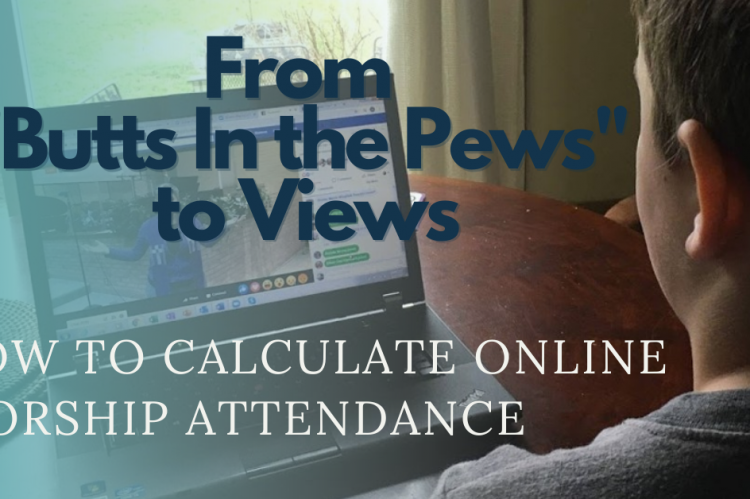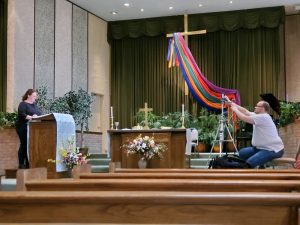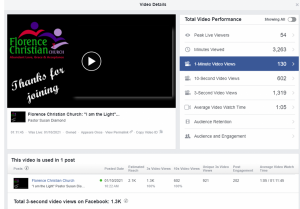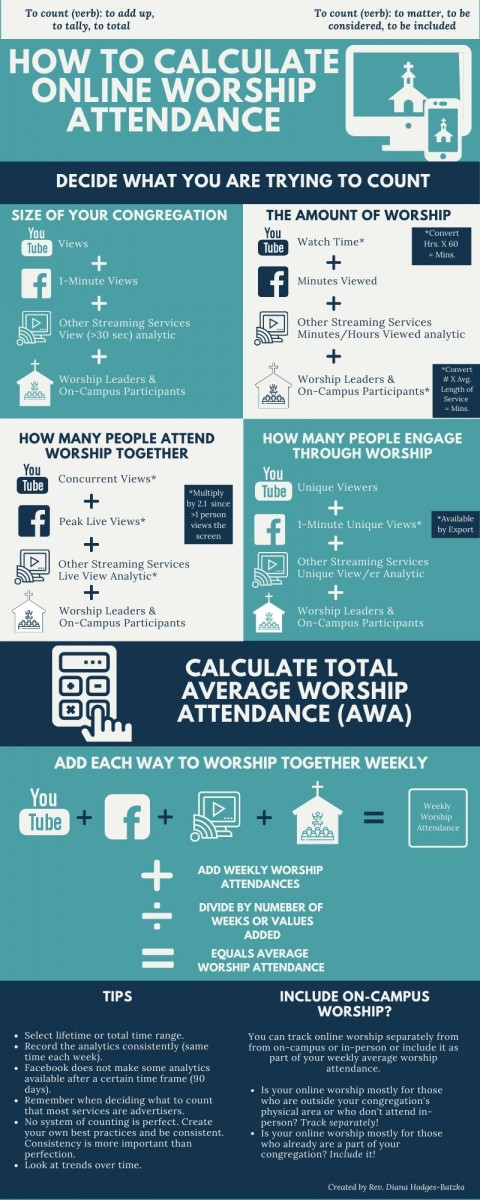From “Butts in the Pews” to Views: How to Calculate Online Worship Attendance
COVID-19 Worship Changes
In 2020, the COVID-19 pandemic necessitated a drastic change in worship practices for Florence Christian Church (Disciples of Christ), located in Florence, KY, a suburb of Cincinnati, OH. Overnight, we had to adapt to provide a safe way to worship due to public health restrictions.
Due to the size of our congregation, our use of a multi-instrument praise band, our state’s specific guidelines, and volunteer and staff ability and energy, we determined we would live stream worship services from our sanctuary to Facebook Live. For the first time in the church’s 189 years, on Sunday March 15, 2020, we turned the pulpit from facing the pews to facing the chancel, connected a phone to a tripod and went live with worship online.
At first, we were delighted to have received thousands of views! Yet, as weeks of live streamed worshiped continued, we began to look at the analytics and insights available from Facebook and YouTube. We discovered that a “view” did not indicate that someone had joined us for worship in what we would consider a meaningful way.
How many people were attending worship?
This is an important question for Florence Christian because we had been tracking our average worship attendance (AWA) for some time as a sign of whether we are fulfilling the mission and vision to which God is calling us.
Yet, with the drastic change from on-campus to online worship, our previously straightforward system to calculate our AWA by counting the number of people present at our Sunday worship services and then averaging the figures together was no longer sufficient. Our process needed to change to meet the new reality of online worship.
How do you calculate your average worship attendance in the age of online worship? Florence Christian has made the decision and investment in technology that it will continue to live stream its worship services, even after the pandemic has waned. The question of what counts as worship attendance may seem a technical question, but is, in fact, one that reveals a new ecclesiology.
A Simple Question Reveals a New Ecclesiology
Prior to the pandemic, the church had two decades of experience with various models of online church. In the 1990s and early 2000s, there were two basic models of churches who were worshipping virtually or online.
- All-Online Virtual Church[1] – The location of these virtual churches was only online, without a “real-world” or physical location or presence. The churches in this model tended to have avatars through which people engaged with each other; They also had ways for people to communicate with each other, including blogs, comments, and other means, as well as opportunities for prayer and worship, all in a virtual world.[2]
- The Internet Campus Model – This model was where a church, most often a megachurch that already had multiple campuses, created an additional stand-alone campus online.[3] A leader in this model is LifeChurch, who in 2006 launched an internet campus, separate from its physical campuses, which included a live stream of worship from one of its physical campuses along with various iterations of chat rooms, opportunities for prayer and conversation among participants, an online pastor, and trained volunteers.[4]
However, the great disruption of COVID-19 has created a different variation of virtual church. This new hybrid church online model is a church that:
- Has a physical, contextual location where people who live in physical proximity to each other worship in-person, and
- Where online worship is available primarily for those same people as well as anyone else who can now join online.
The pandemic accelerated a trend that was already happening with the merging of off-line and online expressions of religion. Researcher Heidi Campbell describes that in our networked society:
“the online is an extension of the offline religious social world . . . It also means that the practice of religion may involve an invisible or seamless flow . . . a sort of online-offline experience of religious hybridity.”[5]
The hybrid on-campus and online worship model being lived out by churches around the globe is an example of the coming together of online and offline experiences to create a new expression of church that is both physical and virtual.
Redefining Average Worship Attendance (AWA)
What is your Average Worship Attendance (AWA)?[6]
The term in this question seems self-explanatory – the average of the number of people who attend worship services over a weekend or week. Yet, with the movement of worship online, we ask: “What does it mean for someone to attend worship online?”
While there are an overwhelming number of analytics available from the various platforms that churches use to worship online, which one best corresponds to in-person worship attendance?
If you are wrestling with this question, my project helps provide a path forward. My project analyzed AWA in terms of an Outcome Thinking Systems Model to discover AWA’s many meanings and uses.[7] This analysis helps you figure out what is being measured when you calculate your AWA.
This model breaks down any process (system) into four parts.
The Outcome Thinking Systems Model
Why apply a systems model to worship? At its core, worship is an essential process (system) of a church. In fact, sociologist Mark Chaves, founder of the groundbreaking National Congregations Study, argues that worship is the primary and defining activity which makes a congregation a congregation.[8]
When the Outcome Thinking Systems Model is applied to worship, you can ask which role AWA plays in what is being measured. Once you discover its role in your system, you can add a comparable analytic available from your online worship platform(s) to calculate your AWA. Using the infographic, you can easily calculate your AWA and measure it over time.
For example, in 2020, Florence Christian Church had a goal of increasing engagement by increasing our AWA by 15%. Using the infographic, we decided AWA was a sign of engagement and calculated our AWA as of mid-February 2021 was 123. We will continue to track this number and see how we can increase engagement both online and offline.
By downloading the “How to Calculate Online Worship Attendance Infographic” you too can calculate your AWA in this new model of offline/online hybrid church.
[1] These types of virtual churches include The Church of Fools, i-Church, St. Pixels, & Second Life. These churches are explored extensively in SimChurch: Being the Church in the Virtual World by Douglass Estes and Creating Church Online: Ritual, Community, and New Media by Tim Hutchings.
[2] Tim Hutchings, Creating Church Online: Ritual, Community, and New Media (New York, NY: Routledge, 2017), 2-9.
[3] Hutchings, Creating Church Online, 168–87.
[4] Hutchings, Creating Church Online, 168–87.
[5] Heidi Campbell, “Understanding the Relationship between Religion Online and Offline in a Networked Society,” Journal of the American Academy of Religion 80, no. 1 (March 2012): 82–83, https://doi.org/10.1093/jaarel/lfr074.
[6] Various churches and denominations may use other language or technical terms.
[7] This breakdown is my model based on the work of Gil Rendle found in Doing the Math of Mission: Fruits, Faithfulness, and Metrics and on descriptions of terms found in Outcome Frameworks by Robert M. Penna and William J. Phillips. The Outcome Thinking Systems Model is in part based on the work of W. Edwards Deming.
[8] Mark Chaves, Congregations in America (Cambridge, MA: Harvard University Press, 2004), 1–2.






